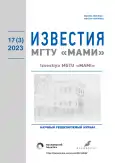Development of the simulation model for testing the axial torque distribution in an electric vehicle with the dual-motor layout
- Authors: Mizin M.D.1, Malyshev A.N.1, Zavatsky A.M.1, Debelov V.V.1
-
Affiliations:
- Central Scientific and Research Institute of Automobiles and Automotive Engines NAMI
- Issue: Vol 17, No 3 (2023)
- Pages: 295-304
- Section: Electrotechnical facilities and systems
- URL: https://journals.rcsi.science/2074-0530/article/view/249930
- DOI: https://doi.org/10.17816/2074-0530-321934
- ID: 249930
Cite item
Full Text
Abstract
BACKGROUND: The market of vehicles using electricity as an energy source demonstrates significant growth. Currently, there are more than twenty million electric vehicles worldwide. Leading manufacturers give the high priority to development of electric transport due to lower vehicle service costs, ease of driving as well as zero emissions in environment and almost complete noiselessness at motion. In addition, using the full-wheel drive in an electric vehicle makes it possible to improve off-road capability, ensures more balanced chassis control, precise following the path and constant accuracy of steering.
AIMS: Ensuring increase in vehicle course stability, delivering the maximal torque regarding vehicle motion conditions and slip control in dual-motor layouts of electric vehicles.
METHODS: In order to solve the given task, implementation of the special-purpose algorithm of torque distribution between driving axles of an electric vehicle is assumed. The paper presents the development of the simulation model of a vehicle, built in the Simcenter Amesim software and considering dynamic properties and features of the vehicle. This model was implemented into the Labcar hardware-in-the-loop facility.
RESULTS: The simulation result is comparison with the data obtained during ground testing of the prototype and confirming the aim of simulation model development, in particular the capability of revision and preliminary setting up the algorithm of torque distribution between driving axles of a vehicle.
CONCLUSIONS: Based on the results of the testing of the developed facility, it can be concluded that the developed simulation facility is suitable for solving the simulation tasks including research, debugging and primary calibrations of the algorithm of torque distribution between driving axles of a full-wheel driven electric vehicle. The errors at simulation of operation modes relevant to longitudinal and lateral dynamics of the prototype is no more than 7.5% that complies with the simulation aims.
Full Text
##article.viewOnOriginalSite##About the authors
Maxim D. Mizin
Central Scientific and Research Institute of Automobiles and Automotive Engines NAMI
Author for correspondence.
Email: maxim.mizin@nami.ru
ORCID iD: 0009-0008-5097-0861
SPIN-code: 2110-3762
Head of Laboratory Calibration Section of High Voltage Systems
Russian Federation, MoscowAndrey N. Malyshev
Central Scientific and Research Institute of Automobiles and Automotive Engines NAMI
Email: andrey.malyshev@nami.ru
ORCID iD: 0000-0003-0233-0348
SPIN-code: 6196-3162
Head of the Hybrid Vehicle Calibrations Department
Russian Federation, MoscowAlexander M. Zavatsky
Central Scientific and Research Institute of Automobiles and Automotive Engines NAMI
Email: aleksandr.zavatskiy@nami.ru
ORCID iD: 0000-0003-0616-1350
SPIN-code: 9509-1069
Design Engineer of the Hybrid Vehicle Calibrations Department
Russian Federation, MoscowVladimir V. Debelov
Central Scientific and Research Institute of Automobiles and Automotive Engines NAMI
Email: vladimir.debelov@nami.ru
ORCID iD: 0000-0001-6050-0419
SPIN-code: 8701-7410
Cand. Sci. (Tech.), Head of the Software Technologies Department
Russian Federation, MoscowReferences
- Nibert J, Herniter ME, Chambers Z. Model-Based System Design for MIL, SIL, and HIL. World Electr. Veh. J. 2012;5(4):1121–1130. doi: 10.3390/wevj5041121
- Husainov A.Sh. Ekspluatacionnie svoistva avtomobilya: uchebnoe posobie. Ul’janovsk, UlGTU, 2011.
- Larin VV. Theory of movement of all-wheel drive wheeled vehicles: a textbook. Moscow: MGTU im NE Baumana, 2010.
- Pasejka HB. Tyre and Vehicle Dynamics. Elsevier Ltd; 2012. doi: 10.1016/C2010-0-68548-8
- Kalachev YuN. Vector regulation (practice notes). Moscow: MEI; 2013. (In Russ.).
- Malyshev A.N, Grunenkov Ye.A, Debelov V.V, et al. Simulation of the insulation monitoring system of the high-voltage electrical network of a vehicle with a hybrid power plant. Izvestiya MGTU MAMI. 2021; 15(2); 36–50. doi: 10.31992/2074-0530-2021-48-2-36-50
- Bendat J, Pearsol A. Measurement and analysis of random processes. Moscow: Mir; 1971. (In Russ.).
- Poon JJ, Kinsy MA, Pallo NA, et al. Hardware-in-the-Loop Testing for Electric Vehicle Drive Applications. In: 2012 Twenty-Seventh Annual IEEE Applied Power Electronics Conference and Exposition (APEC). Orlando: IEEE; 2012. doi: 10.1109/APEC.2012.6166186
Supplementary files















